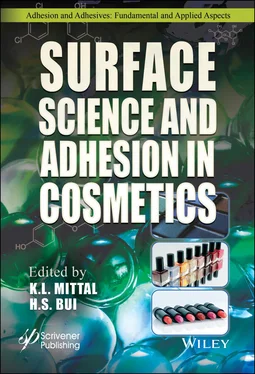Now that we have reviewed technical aspects of the UV cure nail gel coatings technology, we must now look into what the human nail plate presents as a substrate to be coated.
Table 3.4 Properties of the bio-based high solids UV nail gels.
|
Acetone double rubs |
König hardness (Oscillations) |
Pencil hardness |
| Method of curing |
UV-Mercury |
UV-LED |
UV-Mercury |
UV-LED |
UV-Mercury |
UV-LED |
| Base coat |
170 |
180 |
126 |
110 |
H |
2H |
| Polish |
>200 |
>200 |
120 |
114 |
F |
F |
| Top Coat |
>200 |
>200 |
136 |
120 |
3H |
5H |
Table 3.5Properties of the bio-based UV-PUD formulations.
|
Acetone double rubs |
König hardness (Oscillations) |
Pencil hardness |
| Method of Curing |
UV-Mercury |
UV-LED |
UV-Mercury |
UV-LED |
UV-Mercury |
UV-LED |
| Polish |
15 |
12 |
86 |
90 |
HB |
HB |
| Polish including 10 wt.% TMPTA |
45 |
40 |
87 |
94 |
F |
F |
| Polish including 10 wt.% Bomar BR 952 |
15 |
20 |
76 |
76 |
F |
F |
| Non-pigmented formulation including 10 wt.% TMPTA |
40 |
38 |
85 |
90 |
H |
H |
1 a. Before one can coat the human nail plate, one must understand the conditions in which the human nail exists. Researchers determined the surface free energy of the nail plates in vivo. They found that the surface free energy of healthy human fingernail was 34 mJ/m2. Contact angle measurements were accomplished utilizing water, formamide, diiodomethane and glycerol. There are many ways to determine surface free energy of solids using contact angle measurements [18, 19] but here we have used the Lifshitz-van der Waals/acid-base (LW-AB) approach, also known as the van Oss, Chaudhury and Good approach. The in vivo method was performed on 8 females, 9 males who were 23 to 51 years old.
2 b. As can be seen in Table 3.6the surface free energy values for in vivo subjects nail plates are determined using the water-formamide-diiodomethane (WFD) and water-glycerol-diiodomethane (WGD) liquids combinations. These values will be important to understand later in this chapter when we describe the application of UV cure nail gels based on acrylated oligomers and acrylated monomer systems as well as UV curable polyurethane dispersions [20].
The mechanical behavior of the nail is another important factor in understanding how to coat the human nail. Grigale-Sorocina et al [21] evaluated the mechanical properties of the human nail. The formulations in the test conformed to the requirements of the EU Cosmetic Regulations. The formulations included the following: tri-functional urethane acrylate oligomer and a hexa-functional urethane acrylate oligomer. The viscosity was achieved by the addition of the following acrylate monomers for the proper ‘use viscosity’ at various levels: tertisobutyl cyclohexyl acrylate (TBCHA), ethylene glycol dimethacrylate (EGDMA) tetrahydrofurfuryl acrylate (THFA) and hydroxypropyl methacrylate (HPMA). The PI used was TPO that has been shown in Figure 3.15. The UV nail gel coating should match the natural nail plate mechanical properties so that there is no loss of adhesion. Mechanical stress due to shrinkage in the applied UV nail gel coating is the normal cause for this adhesion loss.
As can be seen in Table 3.7Grigale-Sorocina et al. [21] evaluated different monomers and looked at the gel fraction, surface gloss and micro-hardness of the UV cured coatings. They varied the monomer concentration by 30 and 40%. Several of the formulations met the nail coating application viscosity of 3,000 to 4,500 cPa.s. Degree of conversion as shown as gel content was the highest with the formulation using monomer EGDMA with gel fraction (GF) of 96.4% to 98.5%.
Table 3.6 Surface free energy of untreated, hydrated and abraded nail plates.
| Liquid combination used |
State of the nail |
Total surface energy (mJ/m2) γ |
Surface energy components (mJ/m2) |
| Lifshitzvan der Waals γLW |
Acid-base (polar) γAB |
Acid i.e. electron acceptor γ+ |
Basic i.e. electron donor γ |
| WFD |
untreated |
35.5 ± 4.7 |
34.0 ± 3.9 |
1.6 ± 4.0 |
0.4 ± 0.9 |
11.0 ± 7.0 |
|
hydrated |
34.2 ± 3.6 |
33.6 ± 3.8 |
0.7 ± 3.3 |
0.5 ± 1.0 |
11.8 ± 8.7 |
|
abraded |
39.2 ± 3.9 |
37.0 ± 4.2 |
2.2 ± 3.9 |
0.7 ± 1.1 |
9.5 ± 6.5 |
|
|
|
|
|
|
|
| WGD |
untreated |
32.6 ± 6.2 |
34.1 ± 3.9 |
-1.3 ± 5.6 |
-0.1 ± 1.3 |
13.7 ± 7.6 |
|
hydrated |
31.5 ± 6.0 |
33.4 ± 3.8 |
-1.9 ± 4.9 |
-0.2 ± 0.6 |
15.0 ± 8.2 |
|
abraded |
32.9 ± 4.8 |
37.0 ± 4.0 |
-4.0 ± 5.4 |
-0.1 ± 1.4 |
15.4 ± 9.2 |
Table 3.7 Monomers effect on the gel fraction (GF), surface gloss (G) and micro-hardness (HV) of the UV cured cross-linked coatings. Monomers 1-TBCHA, 7-HPMA and 8-HPMA fall into the ɛ β(elongation at break) range of 20-50% so that they exhibit reduced brittleness. AGF=GF 0(is after 72 hours of storage) –GF (is immediately after cure).
| Monomer |
Conc. |
Gel fraction |
Surface gloss |
Microhardness |
| GF |
GF0 |
AGF*/GF0 x 100 |
G |
G0 |
AG**/G0 x 100 |
HV |
HV0 |
AHV***/HV0 x 100 |
|
|
% |
% |
% |
% |
GU |
GU |
% |
MPa |
MPa |
% |
| 1 |
TBCHA |
30 |
97,4 |
98,0 |
0,61 |
46 |
68 |
32 |
104 |
144 |
38 |
| 2 |
TBCHA |
40 |
94,0 |
94,1 |
0,11 |
51 |
72 |
29 |
69 |
83 |
20 |
| 3 |
EGDMA |
30 |
98,5 |
99,3 |
0,81 |
47 |
59 |
20 |
204 |
281 |
38 |
| 4 |
EGDMA |
40 |
96,4 |
98,9 |
2,53 |
47 |
57 |
18 |
220 |
314 |
43 |
| 5 |
THFA |
30 |
96,0 |
96,3 |
0,31 |
59 |
73 |
19 |
25 |
47 |
88 |
| 6 |
THFA |
40 |
95,7 |
96,7 |
1,03 |
54 |
61 |
11 |
28 |
32 |
14 |
| 7 |
HPMA |
30 |
97,0 |
97,6 |
0,61 |
50 |
63 |
21 |
99 |
151 |
53 |
| 8 |
HPMA |
40 |
95,0 |
99,9 |
4,90 |
43 |
58 |
26 |
65 |
134 |
106 |
* AGF = (GF 0– GF)
Читать дальше












